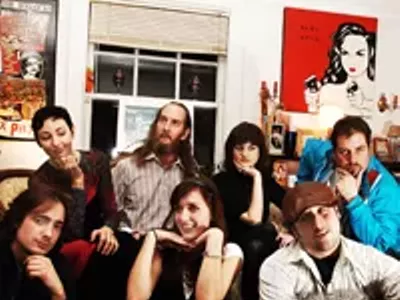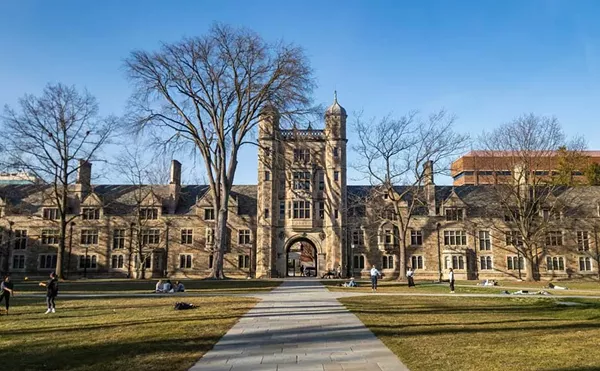When Erica Chappuis looked over the backyard deck at her empty garage wall two years ago, she saw a blank canvas. So the Grosse Pointe Park artist fastened some recycled doors together, painted two figures dancing on them and hung the artwork in her backyard. Next to it she filled the rest of the garage wall with a landscape painting.
As for the front of the house, she wanted to hide the air-conditioning unit she puts in the living room window during the summer months. She'd seen her neighbors conceal garbage cans and other unsightly items with wooden screens; she figured she would create a colorful piece with the same function, painting an African-American woman holding flowers and leading a white horse.
Parents brought their children to look at those paintings and later ones. People stopped and talked to each other. Her neighbors complimented her. And the city wrote her a letter ordering the paintings' removal.
Chappuis' artwork violated the city's sign ordinance, officials said.
"I thought surely there's a mistake, because it would never have occurred to me that anyone would have considered them to be signs. It just seems illogical. I was thinking surely they don't mean the paintings," Chappuis says, "If they had asked to consider the impact on the neighbors, I would have been able to assure them the neighbors were the ones who asked me to continue."
Chappuis' husband, Laurent, an engineer with Ford Motor Co., faces trial Wednesday, Nov. 14, in Grosse Pointe Park Municipal Court. The couple has owned the home together since 1984, and it's Erica Chappuis' artwork, but only her husband is named in the city's complaint. According to his attorney, he faces the possibility of up to $500 in fines or 90 days in jail or both.
City attorney Niesa Trent didn't respond to our requests for comment.
The couple contends the artwork is speech and expression that is protected by the U.S. Constitution. Grosse Pointe Park officials say the paintings violate the city code that requires permits for signs.
Grosse Pointe Park Municipal Court Judge Carl Jarboe refused to dismiss the case at the Chappuises' request earlier this year. Under the city's zoning ordinance, he wrote in his ruling, paintings may be considered illustrations or displays under the definition of a sign. He also said the city's ordinance as written is "content neutral," meaning it does not discriminate against the nature of the message when it has the effect of regulating speech.
"By restricting the display of signs and where they can be displayed, the city's content-neutral ordinance is narrowly tailored in order to carry out the city's objective of ensuring the quality and character of its neighborhoods," Jarboe wrote.
But the Chappuises' Grosse Pointe Park attorney, William Burdett, says the city's ordinance goes too far. "To have that system set up is a chill on speech," he says. "The point of the First Amendment is we don't tolerate restrictions on creative speech. We say if it's overly broad, if it chills speech, if it has the potential of ever chilling speech, it's unconstitutional."
Robert Sedler, a Wayne State University professor of law and a First Amendment scholar, also views the city's ordinance as "content neutral" and says it's constitutional because it allows for certain signs.
"It allows temporary signs, that's for political purposes, but basically this is aesthetic stuff. People don't want that kind of stuff in their neighborhoods. It looks bad to people who have their homes in Grosse Pointe Park," he says.
He said banning paintings, as the city is doing, isn't unconstitutional. "It's not as if you're banning the expression of the idea," he says. "They're not going to win."
Chappuis has the support of her neighbors in her fight to keep her art displayed. About 75 of them signed a petition for her. Homeowners on both sides of her told Metro Times they like her paintings.
"I just think they're beautiful," says Norma Housey, her neighbor to the north. "She took something that could have looked like blight and made it look pretty. I think that the city forgets that it's the people who pay their salaries. We're the ones that voted them in and they're spending too much time and money on this."
Chappuis believe she's improved the area and objects to the city prosecuting her two-dimensional art when yard sculptures, fountains and commercial holiday decorations are allowed.
"I think that art revitalizes any neighborhood," she says. "To a neighborhood, I think it gives people something to look at and people to talk about."
Sandra Svoboda is Metro Times staff writer. Contact her at 313-202-8015 or [email protected]





